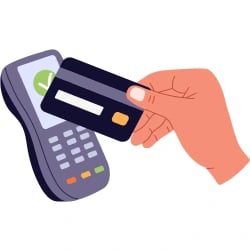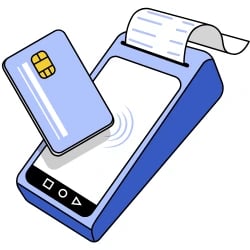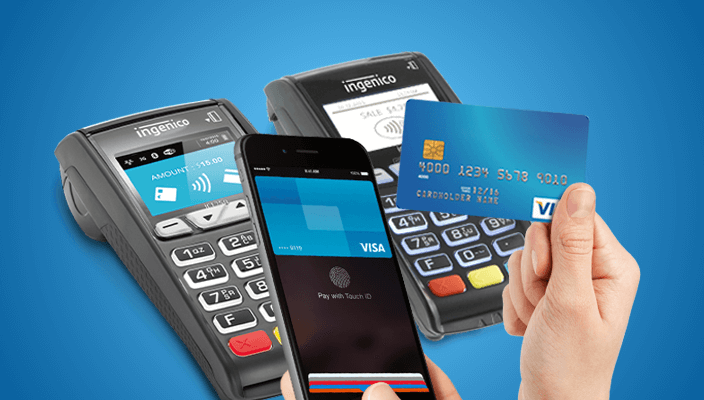EMV technology plays a pivotal role in enhancing the security and efficiency of credit card transactions. Understanding the ins and outs of EMV is crucial in a digital age where the threat of credit card fraud is ever-present. What is EMV? Join us as we explore the significance of EMV technology and EMV readers, how they work, their challenges, and how they compare to other popular technologies, such as NFC.
What Is EMV and Why Is It Important?
EMV is a global standard for secure payment transactions. Leading financial institutions initially created EMV, but EMVCo, an international technical organization, now manages the standard. EMV is characterized by the small computer chips found on credit, debit, and prepaid cards, which store cardholder information more securely than magnetic stripes.
EMV's ability to combat counterfeit fraud is of the utmost importance for cardholders. The unique transaction codes generated by EMV chips significantly enhance transaction security, making it a vital component in the global payment landscape.
What Does EMV Stand For?
EMV stands for Europay, Mastercard, and Visa. The name originates from the three companies that initially developed the standard. While Mastercard and Visa still operate on a global scale, Europay stopped operating independently in 2002 and joined forces with Mastercard International, resulting in the formation of Mastercard, Inc. Throughout its tenure, Europay stood as one of the two major credit card processors alongside Visa, wielding significant influence in the European market.
How Does Credit Card Chip Technology Work?
In the past, magnetic stripe cards and signatures left room for fraud. However, EMV chips generate unique transaction codes on an EMV card reader, significantly reducing the risk of data interception and criminal reuse.
When you insert an EMV card into a payment terminal, it initiates a process known as "dipping," which is more secure than the traditional "swiping" of magnetic stripe cards. Chip-and-signature or chip-and-PIN verification is also offered nowadays, adding an extra layer of security to transactions. Contactless payments are also possible with EMV cards, eliminating the need for a PIN.
Advantages of Using EMV Cards
Here are three advantages of using EMV cards:
- EMV chips encrypt data dynamically. Because the data changes over time, it is challenging for fraudsters to compromise card information. EMV chip technology enhances the security of in-store payments and is a primary payment method for mobile card readers.
- EMV technology is a global standard. EMV cardholders can confidently use their cards while traveling internationally, as they are compatible with any EMV reader.
- Merchants who adopt EMV technology demonstrate their commitment to security and regulatory compliance. This helps to earn customers' and business partners' trust, as it signifies a proactive stance in protecting sensitive data.
Challenges and Concerns with EMV
Despite successfully reducing card-present fraud, EMV technology falls short in safeguarding card-not-present transactions, particularly in the realm of online shopping. EMV Specifications have expanded to address this vulnerability to include solutions like EMV 3-D Secure, EMV Secure Remote Commerce, and EMV Payment Tokenization.
It's worth noting that the security of EMV technology relies heavily on merchants' payment processing systems. Those lacking proper encryption are leaving payment data vulnerable.
EMV Compliance: What It Means for Merchants and Consumers
EMV compliance, the global standard for card processing, means adopting secure chip technology in cards and terminals. While it enhances security for merchants, it requires new POS equipment and shifts liability. This builds consumer trust and provides benefits like enhanced card security and reduced fraud. EMV is rapidly spreading, especially in Canada and Europe, where POS systems feature EMV-compatible card readers. Visa, Mastercard, Discover, or AMEX chip cards are inherently EMV compliant.
What Is an EMV Reader?
An EMV reader also called a chip card reader, processes secure transactions with EMV chip-enabled cards. These readers authenticate cards, verify transactions, and enhance security with unique transaction codes.
EMV readers have a slot for chip insertion, improving security by generating unique codes for each transaction. They're commonplace at retail POS terminals, accommodating various payment methods, including contactless and mobile wallets. The average cost for an EMV card reader is $500 to $1,000.
Here's how EMV readers work:
- Card Insertion — When customers initiate a payment, they insert their EMV chip card into the designated slot or contact point on the EMV reader.
- Card Authentication — The EMV reader scans the chip's data, which includes card details like the card number and expiration date.
- Transaction Verification — The EMV chip generates a unique transaction code, often called a "cryptogram," to verify the transaction's legitimacy.
- Cardholder Verification — The cardholder may be prompted for additional verification, such as entering a PIN or providing a signature. This step ensures that the card user is the authorized cardholder.
- Transaction Processing — The EMV reader communicates with the card's chip to perform security checks and execute the payment transaction. Transaction details are then transmitted to the payment processor for approval.
- Transaction Completion — If the transaction goes through, the merchant's account receives payment. The EMV reader then generates a receipt or provides electronic confirmation of the successful transaction.
Equipment and Requirements for EMV Transactions
To facilitate EMV transactions, merchants must invest in an EMV reader. These terminals feature a card slot or insertion point to read and process chip-enabled cards. Merchants must ensure their equipment is both EMV-certified and regularly updated to the latest software. A secure internet connection is also essential for transmitting transaction data to the payment processor and obtaining authorization for EMV transactions. Additionally, partnering with a payment provider or acquirer that supports these types of transactions is important.
Merchants should verify that the chosen payment provider is EMV-certified and adheres to the necessary security protocols. Furthermore, it's good to train merchant staff in using an EMV card reader and educate customers on the chip card insertion process. Depending on the type of EMV card and issuer requirements, merchants may need to accommodate cardholder verification methods such as PIN entry or signature capture. Given the surging popularity of contactless payment methods such as Apple Pay and Google Pay, merchants may find it beneficial to support these options.
What Is The EMV Liability Shift?
Before EMV adoption, issuers were typically accountable for fraudulent transactions. The EMV liability shift transferred this responsibility to businesses that had not yet upgraded to an EMV chip reader. Merchants must equip their POS terminals with EMV compatibility to avoid liability for counterfeit card transactions, and card issuers must provide chip-enabled cards. Specifics regarding the liability shift, including the effective date and regulations, may vary by region and payment network.
EMV vs. NFC
EMV Technology enhances in-person transaction security by employing microprocessor chips, prioritizing secure payment processing. Cardholders insert their cards into an EMV reader, which may prompt additional verification steps. EMV is designed primarily for secure face-to-face payments made at physical POS terminals.
NFC (Near Field Communication) is synonymous with contactless payments and emphasizes convenience and user authentication. It extends beyond payments to mobile ticketing, access control, and remote transactions.
Both EMV and NFC are prevalent in payment processing. While NFC is often associated with contactless phone payments, both technologies adapt to various payment scenarios. Many payment terminals accept NFC and EMV payments, while some exclusively support one. However, remember that NFC/EMV readers don't work with magnetic stripe cards.
Final Thoughts on EMV
EMV features small computer chips on cards that securely store cardholder information, rendering magnetic stripes obsolete. The importance of EMV is unmistakable, primarily in its role in combatting counterfeit fraud through the generation of unique transaction codes. Despite its success, challenges in safeguarding card-not-present transactions remain. Yet, EMV continues to gain traction and signifies a commitment to security and regulatory compliance for businesses and peace of mind for consumers. To learn about making your business EMV-compliant, consider a payment processor with the expertise to help you get started.
Frequently Asked Questions (FAQs)
EMV chips enhance payment security significantly. They are designed to prevent fraudulent transactions, reducing certain types of credit card fraud. Unlike magnetic-stripe cards with static data vulnerable to cloning, chip cards use dynamic data, making duplicating extremely hard. Additionally, chip cards employ advanced encryption right on the chip, ensuring secure communication with the payment terminal and verifying the cardholder's identity. This makes EMV a more secure payment method than traditional magnetic stripe cards.
Merchants who don't accept EMV chip cards could be liable for any fraudulent transactions involving chip cards after October 1, 2015. This change shifted the responsibility for counterfeit fraud from card issuers to the party that invested the least in chip technology, whether it's the merchant or the issuer. If a customer uses a chip card with a merchant that doesn't have a certified chip card terminal, the merchant may bear the cost of any resulting fraudulent transactions.
Magnetic stripe cards were the standard for credit card transactions, where data was read by swiping the card through a terminal. EMV chip cards, introduced later, work differently. With EMV, one inserts a card into a terminal with the chip facing in, making direct contact. The chip verifies the card issuer and PIN and then provides a one-time code for the transaction, making each transaction unique. In contrast, magnetic stripe transactions collect static data from the card's magnetic strip, including card number and expiration date. This static data makes it easier for fraudsters to clone cards. EMV chip cards significantly enhance security and reduce the risk of counterfeit fraud compared to magnetic stripe cards.
EMV technology adoption is a priority for businesses in regions where it's the credit card standard. Industries like retail and restaurants benefit from it, reducing fraud risk. It provides enhanced security, competitive advantage, and customer trust. However, adoption should be evaluated based on the business's specific context, especially if it primarily operates online or in niche markets.






